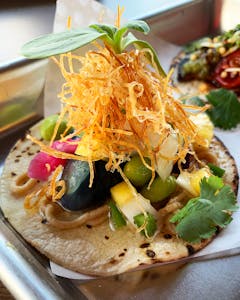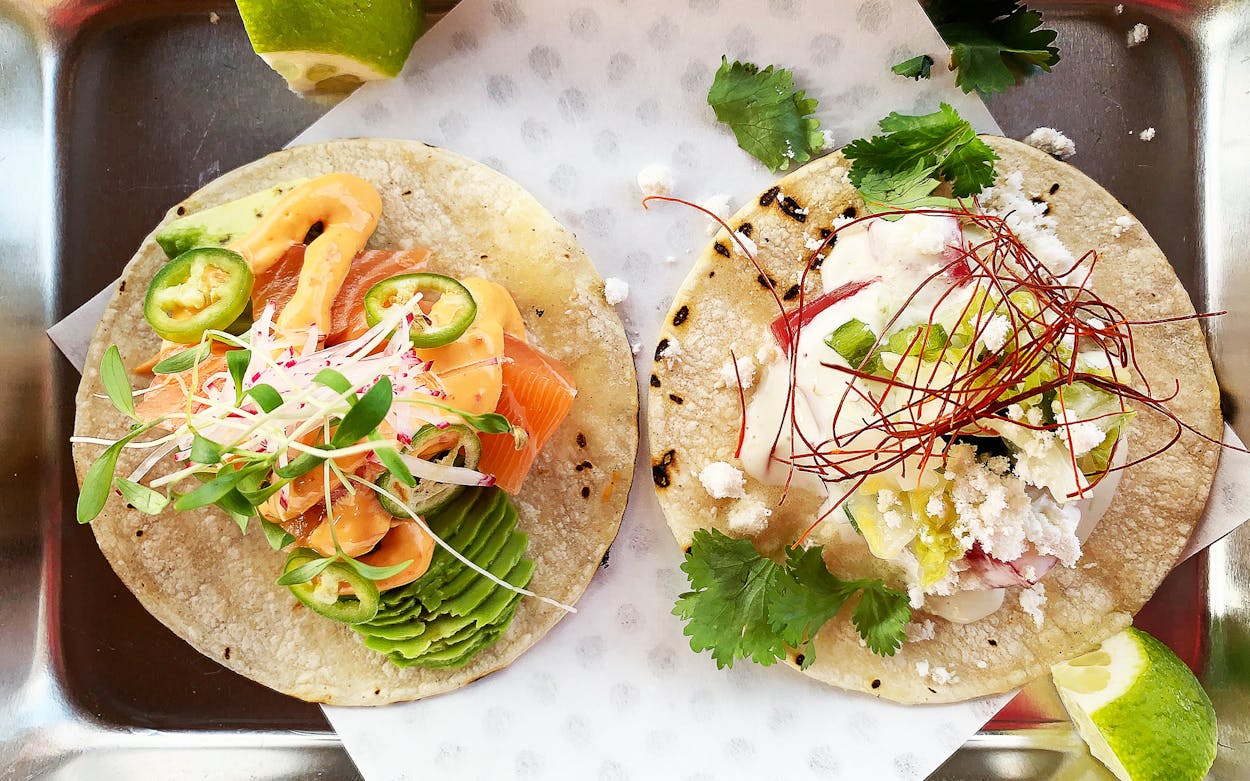Situated in a beige strip mall in Irving’s Las Colinas development, alongside office parks and chain hotels, Edoko Omakase may not look like much from the outside. But the food at this two-month old Japanese restaurant turned my world sideways during a recent visit. Owned by Sara Nam, who is behind similarly named Edoko Sushi and Robata in Irving and Frisco, the latest concept is built around the omakase concept—a multicourse meal during which the customers leave the menu up to the kitchen staff—from the small team of cooks overseen by executive chef Keunsik Lee. But I wasn’t there for the chef-inspired sushi and sashimi plates. I was there for the tacos.
Edoko Omakase was recommended to me by members of the Asian Grub in DFDUB (DFW) Facebook group, organized by Asian restaurant owners and fans in the wake of racist backlash during the early days of the COVID-19 pandemic. The tacos here are listed only on an available-by-request menu. Topped variously with pink-and-white-striped salmon belly, tuna, a smattering of vegetables, and freshwater eel, all four tacos are served on a locally sourced, lightly grilled corn tortilla. They’re capped with garnishes such as squiggles of chile-infused crema and thinly sliced serrano chiles. Small lime wedges finish things off. The salmon belly is served on a creamy fan of avocado slices. My favorite was by far the unagi (freshwater eel) with plump halved cherry tomatoes and a peppy, silky wasabi salsa verde, seeds included. The modern presentation, thoughtful layering of flavors, and balance of textures left me stunned. I had to ask myself: was this a one-off, or are Japanese tacos a developing, even codified style of taco?
The question made me think about puffy tacos and Korean tacos. The latter developed organically from the exchange of ingredients, including tortillas, between Korean and Mexican immigrant communities in Los Angeles in the eighties and nineties. Korean tacos burst onto the mainstream culinary landscape in 2008, when Roy Choi rolled out his Kogi BBQ Korean taco truck across L.A. and inspired entrepreneurs across the nation to prepare and sell what I call K-Mex. Within two years, Korean tacos had claimed a permanent berth in the taco canon. (I dedicate a chapter to K-Mex in my book, American Tacos: A History and Guide.)
I wondered if Japanese tacos could become an enduring culinary product—not unlike taco rice, invented in the mid-eighties to cater to Americans on the Japanese island of Okinawa. In short: do they have staying power?
My first experience with Japanese-style tacos was during a book research trip to New York City’s bustling Chelsea Market and the Takumi Taco food stall. I wedged myself onto a stool at the taqueria’s counter, where I watched the cooks deftly handle fried gyoza shells and sashimi tuna while I enjoyed the Sapporo-braised short-rib taco. In my book, I described the sauces as “tangy Japanese mustard” and “prickly-yet-mellow yuzu avocado salsa.” From this, you might assume that Japanese tacos are a brand-new “fusion” invention. But their history has roots going back to the early days of Spain’s colonization of Mexico and the Spanish empire’s expansion into Asia.
From 1565 to 1815, Spanish trading ships sailed between Acapulco and Manila, in the Philippines. The year-long round-trip was cause for celebration in New Spain. A ship’s return was often feted with a large market of international goods that attracted government officials from Mexico City. These centuries of commerce between Asia and North America introduced novel spices and foodstuffs that set off waves of innovations across the globe. Today, this history is especially prominent in the seafood dishes of Mexico’s western coastal states, including what is now California and into southern Arizona. Perhaps the clearest contemporary example is Mexican sushi, marked by concoctions integrating carne asada, shrimp, cream cheese with eel sauce, or chipotle mayo. Few examples, if any, of Mexican sushi are available in Texas. The Asian culinary influence is stronger in Peru, whose gastronomy is heavily informed by the first wave of Japanese immigrants more than a century ago. One prominent example is ceviche, the raw seafood dish that’s also popular in Mexico and the United States. Ceviche is an ideal topping for tostadas, crispy flat corn tortillas.

In the last century, a few other Texas restaurants have experimented with Japanese tacos. Reliant on sashimi and typical Japanese street foods, this style likely first popped up in Texas as a way to contextualize sealed gyoza—not unlike the way some tacos are sealed prior to frying—as cited in the May 4, 1971, installment of the “Editor’s Corner” column in the El Paso Herald-Post. The comparison is a stretch; tacos and gyoza are dramatically different sizes. In 1979, a brief item in Jim Trinkle’s “Skyline” column in the Fort Worth Star-Telegram mentioned the forthcoming VIP Supper Club that “would have the only Japanese tacos ’tween here and Tokyo.” (Emphasis not added.) They would share menu real estate with calf fries. Nearly a year later, the restaurant’s Japanese tacos, made by co-owner Ed Bannister’s wife, Susako, were mentioned again by the same critic. Trinkle wrote: “If you don’t like those, it’s sayonara, senor [sic].” Whether these tacos used the requisite tortilla or subbed in a dumpling wrapper or lettuce leaf—therefore technically disqualifying them as tacos—isn’t clear. The spot remains in business as the VIP Lounge remains in business on White Settlement Road. It’s morphed into a darkly lit dive bar with neon beer signs, pool tables, and shot specials—no tacos in sight.
More recently, the Oyama food truck, which specialized in blending Japanese and Mexican cuisines, operated in Austin for two-and-a-half years before closing in 2015. Co-owned by Luis Robledo (currently of Cuantos Tacos), the mobile food vendor served such tortilla-enveloped treats as street-style tacos filled with carnitas braised in a beer-and-dashi broth. Robledo, who recently relocated his truck to East Austin’s Arbor Food Park, says he might experiment with Japanese-style tacos again, eventually. “I have joked around with the idea of getting with my old business partner and doing the menu on a Sunday just for fun,” he says.
Sushi and tacos actually have a lot in common, Robledo points out. Both cuisines hold the balance of flavors and textures in high regard. The components are analogous, too. “The most important part of the taco is the tortilla. It’s the foundation,” he says. “For sushi, the most important ingredient is the rice.” Next is the filling. Whether lengua or tuna, the fillings must be tender and sliced or chopped perfectly. Then there’s an aromatic element, which is wasabi for sushi. Cilantro and onions are the aromatics applied to tacos. After that, there is the acidity from the lime or pickled ginger. “The cherry on top, the big finish, is the brush of soy sauce or the salsa. … Of course, they both have to be eaten on the spot.” The idea of sitting at a sushi bar waiting for your order and watching it being made is much the same as waiting for the taquero to shave delicate slices of pork al pastor from a trompo and nick the pineapple atop the vertical spit with a flourish. There is magic and art and finesse and expertise. Tacos deserve the same prestigious platform as sushi.
At Edoko Omakase, they receive that distinction. The same custom orders of seafood shipped from Japan three times a week are used in the tacos. Lee finds inspiration in foundational components like pico de gallo, which he transforms into kimchi de gallo—noting that raw white onion resembles the white cabbage used for the staple dish of his native Korea—and adds a second condiment, wasabi aioli, which caps cool, tender layers of tuna sashimi. Tiny tumbleweeds of powdered olive oil, produced when the liquid is introduced to tapioca powder, resemble cotija cheese and add a touch of whimsy. Lee’s love of tacos come from his time working under celebrity chef (and Iron Chef) Masaharu Morimoto at Japonais in Chicago, where he was encouraged to explore and dive in fingers first—as a former racer and automotive engineer, Lee loves working with his hands. He also worked alongside a diverse kitchen staff from across Latin America. When he returned to Texas, after a stint in Philadelphia, Lee took his experience, especially his exposure to different taco styles, and dug in.
Lee encourages his chefs to explore their own cultural backgrounds and influences when preparing their omakase plates. He also insists that a taco is always one of the several courses offered in any omakase. It’s how seriously he approaches his tacos. “The main concept is Japanese cuisine. But I’m going to bring all the background experience to that plate,” Lee says. “I don’t want to add crazy things on that really good stuff. The focus is on the flavor itself, the fish itself, and then I can add some of the really original taco stuff, like salsa with a little bit of Asian flavor,” he explains. His respect for the taco, not to mention for sashimi and high-quality ingredients, is clear and compelling. What Lee creates at Edoko Omakase sets the standard for Japanese tacos in Texas.
To answer the question directly: yes, Japanese tacos are here to stay.
Edoko Omakase
1030 W. John Carpenter Freeway, Suite 100, Irving
Phone: 972-600-8626
Hours: Monday–Friday 11 a.m. to 9:30 p.m., Saturday 5 to 9:30 pm








